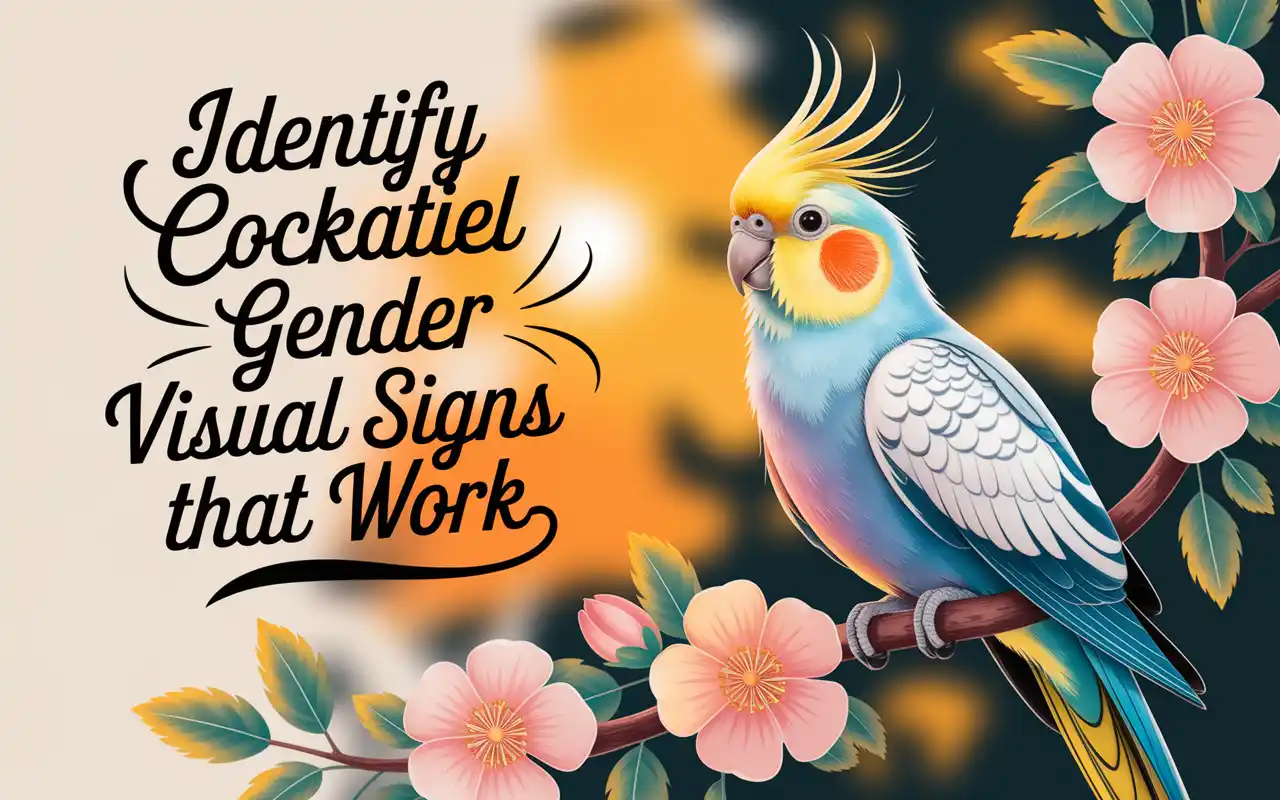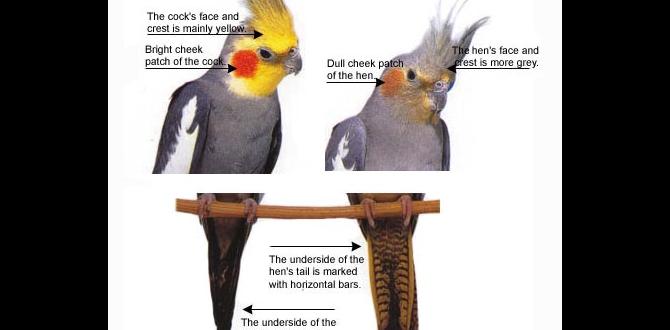Have you ever wondered if your cockatiel is a boy or a girl? It’s a puzzle many bird owners face. But don’t worry, there are visual signs to tell if your cockatiel is male or female. Imagine how fun it would be to solve this mystery with just a glance at your feathered friend!
Let’s start with a simple story. Julia has a cockatiel named Sunny. Julia always thought Sunny was a girl. One day, Sunny started singing more and showing bright cheek patches. Could these be signs that Sunny is actually a boy? Like Julia, many pet owners look for clues. These clues are not as hard as you might think to spot!
Understanding your cockatiel’s gender can help you connect better. It also helps you take care of them the best way. Are you ready to unlock the mystery and see what secrets those feathers hide? Dive in and let’s discover how to read the special signs together!

Understanding Visual Signs: Male Vs. Female Cockatiel

Visual Signs to Tell if Your Cockatiel is Male or Female
How do you know if your cockatiel is a boy or girl? Males often showcase brighter, more vivid cheek patches. Females may have barred tail feathers and a softer song. Their behaviors differ too; males often sing and whistle more. Check under their wings; females might have spots. Isn’t it cool how nature gives these clues to help us tell them apart? Your feathery friend hides its secret in plain sight!
Understanding Cockatiel Gender Differences
Physical characteristics and their significance. Behavioral cues distinguishing males from females. Understanding Cockatiel Gender Differences
Did you know cockatiels have unique signs showing if they’re a boy or a girl? Males often show brighter colors, especially on their cheeks. They even have striking yellow faces! Females tend to have spots under their tails and their faces are not as yellow.
Behavior clues help too! Male cockatiels love to whistle and sing fancy songs. Females keep things quieter. Knowing these fun traits makes it easy to tell them apart!
How can I tell if my cockatiel is a male or female?
Check their colors and behavior! Look for bright face colors and active singing in males. Watch for tail spots and softer songs in females!
Head and Facial Markings
Identifying features in male cockatiels. Unique markings commonly found in females.
Have you ever wondered if your pet cockatiel is male or female? You can tell by looking at their head and face! Male cockatiels have bright yellow cheeks and faces. Their heads often look like they’ve been painted with sunshine. Females, however, have more muted colors. They show grey and softer yellow patterns. It’s like the male cockatiel is wearing a vibrant costume, while the female enjoys a subtle look.
How do you know if a cockatiel is male or female by looking?
It’s simple! Check the face. Males sport bright yellow around the cheeks and head. Females wear more toned-down grey or pale yellow shades.
Body and Feather Patterns
Color variations observable in different genders. Specific patterns used as gender indicators.
Did you know male and female cockatiels have different feather patterns? Male cockatiels often have brighter feathers. They may have solid yellow faces and bright cheek patches. Females usually have duller colors. Their faces might be more gray. Look for barred tail feathers in females; these look like stripes. Males rarely have these stripes. Both males and females have unique patterns. Spotting these patterns can be a fun way to tell their gender!
How can you tell if a cockatiel is a boy or girl?
You can tell by their feather patterns. Males often have bright yellow faces, while females are duller. Check their tails for stripes; females usually have them.
Vocalization and Behavior Traits
Distinct vocal patterns in male cockatiels. Behavioral differences noticeable in female cockatiels.
Cockatiels sing and make different sounds. Male cockatiels often whistle, sing, and mimic sounds. They love to perform and can be quite chatty. Females, on the other hand, are usually quieter. They may chirp but rarely sing. You might notice different behaviors too. Males like to show off by dancing. Females may spend more time nesting. Knowing these differences can help you tell males from females.
Why do male cockatiels sing more?
Male cockatiels sing more because they’re showing off. They use songs to attract mates. Their tunes can be long and fancy. Singing is their way to say, “Hey, look at me!”
What behaviors do female cockatiels show?
Female cockatiels are mostly calm and quiet. They may spend time nesting or sitting on perches. They also like to make a nesting spot cozy. Watching these habits helps identify them.
Tail Feathers and Wing Patterns
Comparison of tail feather characteristics. Genderspecific wing markings to look for.
Look at your cockatiel’s tail feathers. Males have solid gray feathers, while females show more patterns with yellow spots and bars. Now, check the wing patterns. Males often have sleek, plain wings. Females have dotted or striped wings. Spotting these clues helps discover if your bird is male or female.
How can you tell a male cockatiel from a female?
Males usually have brighter cheek patches, sing more, and display fewer feather patterns. Females are quieter, with barring under their tail and more patterns on their wings. These differences help in identifying genders.
Mature Cockatiel Identification
Changes in appearance with maturity. Importance of age in accurate gender identification.
As cockatiels grow, some changes help us know if they are boys or girls. Males often have bright cheek patches and face colors. Females might have softer colors or spots under their tails. It’s important to be patient. It is best to check when cockatiels are at least nine months old. This is when their colors show clearly. Look for these differences to better understand your pet’s gender.
How can you tell if a cockatiel is mature?
Feather patterns, bright face colors, and behaviors show maturity. Cockatiels under eight months may not show these signs. Watch for changes after this age.
Do cockatiels change color as they grow?
Yes, colors can change with age. Male cockatiels often become more vibrant. This change helps tell them apart from females.
Exceptions and Special Cases
Recognizing hybrid or mutation variations. Factors affecting typical visual cues.
Some cockatiels don’t play by the rules, especially those with unique hybrid or mutation variations. These feathered rebels can leave us guessing their secrets. Their visual cues might be camouflaged by fancy plumage or playful patterns. Did you know that diet and environment can also trick the eye? A tail feather in bright sunlight may prompt gasp-worthy surprises. Stay sharp, and keep your eyes peeled for the unusual!
| Variation | Visual Cues |
|---|---|
| Lutino | Bright yellow, hard to distinguish |
| Pied | Spotted patterns, mixed signals |
So next time you think you’ve cracked the case, remember: nature loves a fun twist, and your cockatiel might just be part of the club. Keep observing, and you just might catch their hidden identity in action!
When to Consult a Professional
Situations requiring expert verification. Benefits of DNA testing for confirmation.
Sometimes, figuring out your cockatiel’s gender is like solving a tiny bird mystery! If your feathered friend is being difficult to categorize, it’s a good idea to ask a pro. Expert bird watchers or vets can offer accurate help. Plus, DNA testing is a trusty way to confirm if you’re genuinely singing “My Boy Lollipop” or “Ain’t She Sweet!” DNA testing boasts a success rate of more than 99%, so it’s like pointing to the right clue with a wink!
| Scenario | Action |
|---|---|
| Behavior differences | Consult a specialist |
| Color and markings confusion | Seek expert advice |
| DNA option | Get a gender test |
If your cockatiel doesn’t fit the common cues, don’t stress! Calling in an expert is like having your own bird detective! With DNA testing, you’ll crack the case surely, without any guesswork.
Conclusion
To tell if your cockatiel is male or female, look for visual signs. Males often have brighter colors and sing more. Females typically have bars under their tails. Remember, these traits can vary. If unsure, ask a vet for help. Keep observing your bird for more clues. Consider reading more about cockatiels for extra tips.
FAQs
What Are The Differences In Color Patterns Between Male And Female Cockatiels?
Male and female cockatiels have different colors. Males usually have bright yellow faces and orange cheeks. Females often have gray faces with lighter cheeks. You might also see stripes under the female’s tail. These patterns help us tell them apart.
How Do The Tail And Wing Markings Help Determine The Gender Of A Cockatiel?
When you look at a cockatiel, the tail and wing markings can tell you if it’s a boy or a girl. Boy cockatiels usually have brighter markings, while girl cockatiels have more spots or stripes. The tail of a girl often has lines, while the boy’s tail is more solid. This makes it easier to guess if your pet bird is a he or a she!
Are There Behavioral Differences That Can Indicate Whether A Cockatiel Is Male Or Female?
Yes, there are some differences. Male cockatiels often sing more and learn to whistle tunes. They also bob their heads and flap their wings a lot. Female cockatiels are usually quieter and may not whistle as much. Watching them play can help you learn which is which!
Can The Cheek Patch Colors Provide Clues About A Cockatiel’S Gender?
Yes, cheek patch colors can help us tell if a cockatiel is a boy or a girl. Boy cockatiels usually have bright orange cheek patches. Girl cockatiels often have duller, lighter cheek patches. When we see these colors, we get clues about whether the bird is male or female.
Are Certain Vocalizations Or Sounds More Common In Male Or Female Cockatiels?
Yes, male cockatiels often sing more than females. They like to whistle and can learn many tunes. Female cockatiels make more chirps and squawks instead. Both can make funny sounds, but males are usually more musical.
